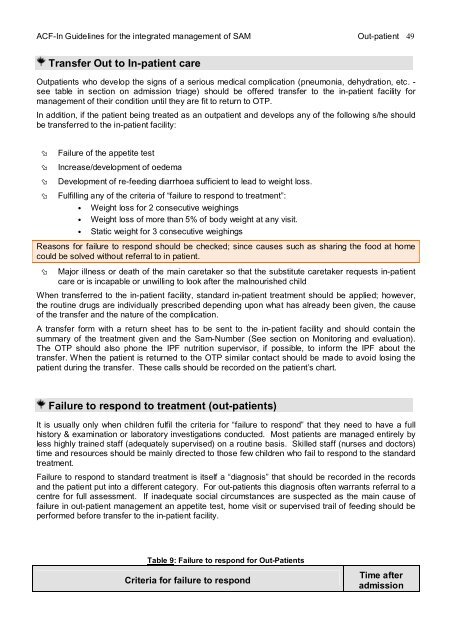guidelines for the integrated management of severe acute malnutrition
guidelines for the integrated management of severe acute malnutrition
guidelines for the integrated management of severe acute malnutrition
Create successful ePaper yourself
Turn your PDF publications into a flip-book with our unique Google optimized e-Paper software.
ACF-In Guidelines <strong>for</strong> <strong>the</strong> <strong>integrated</strong> <strong>management</strong> <strong>of</strong> SAM Out-patient 49<br />
Transfer Out to In-patient care<br />
Outpatients who develop <strong>the</strong> signs <strong>of</strong> a serious medical complication (pneumonia, dehydration, etc. -<br />
see table in section on admission triage) should be <strong>of</strong>fered transfer to <strong>the</strong> in-patient facility <strong>for</strong><br />
<strong>management</strong> <strong>of</strong> <strong>the</strong>ir condition until <strong>the</strong>y are fit to return to OTP.<br />
In addition, if <strong>the</strong> patient being treated as an outpatient and develops any <strong>of</strong> <strong>the</strong> following s/he should<br />
be transferred to <strong>the</strong> in-patient facility:<br />
� Failure <strong>of</strong> <strong>the</strong> appetite test<br />
� Increase/development <strong>of</strong> oedema<br />
� Development <strong>of</strong> re-feeding diarrhoea sufficient to lead to weight loss.<br />
� Fulfilling any <strong>of</strong> <strong>the</strong> criteria <strong>of</strong> “failure to respond to treatment”:<br />
• Weight loss <strong>for</strong> 2 consecutive weighings<br />
• Weight loss <strong>of</strong> more than 5% <strong>of</strong> body weight at any visit.<br />
• Static weight <strong>for</strong> 3 consecutive weighings<br />
Reasons <strong>for</strong> failure to respond should be checked; since causes such as sharing <strong>the</strong> food at home<br />
could be solved without referral to in patient.<br />
� Major illness or death <strong>of</strong> <strong>the</strong> main caretaker so that <strong>the</strong> substitute caretaker requests in-patient<br />
care or is incapable or unwilling to look after <strong>the</strong> malnourished child<br />
When transferred to <strong>the</strong> in-patient facility, standard in-patient treatment should be applied; however,<br />
<strong>the</strong> routine drugs are individually prescribed depending upon what has already been given, <strong>the</strong> cause<br />
<strong>of</strong> <strong>the</strong> transfer and <strong>the</strong> nature <strong>of</strong> <strong>the</strong> complication.<br />
A transfer <strong>for</strong>m with a return sheet has to be sent to <strong>the</strong> in-patient facility and should contain <strong>the</strong><br />
summary <strong>of</strong> <strong>the</strong> treatment given and <strong>the</strong> Sam-Number (See section on Monitoring and evaluation).<br />
The OTP should also phone <strong>the</strong> IPF nutrition supervisor, if possible, to in<strong>for</strong>m <strong>the</strong> IPF about <strong>the</strong><br />
transfer. When <strong>the</strong> patient is returned to <strong>the</strong> OTP similar contact should be made to avoid losing <strong>the</strong><br />
patient during <strong>the</strong> transfer. These calls should be recorded on <strong>the</strong> patient’s chart.<br />
Failure to respond to treatment (out-patients)<br />
It is usually only when children fulfil <strong>the</strong> criteria <strong>for</strong> “failure to respond” that <strong>the</strong>y need to have a full<br />
history & examination or laboratory investigations conducted. Most patients are managed entirely by<br />
less highly trained staff (adequately supervised) on a routine basis. Skilled staff (nurses and doctors)<br />
time and resources should be mainly directed to those few children who fail to respond to <strong>the</strong> standard<br />
treatment.<br />
Failure to respond to standard treatment is itself a “diagnosis” that should be recorded in <strong>the</strong> records<br />
and <strong>the</strong> patient put into a different category. For out-patients this diagnosis <strong>of</strong>ten warrants referral to a<br />
centre <strong>for</strong> full assessment. If inadequate social circumstances are suspected as <strong>the</strong> main cause <strong>of</strong><br />
failure in out-patient <strong>management</strong> an appetite test, home visit or supervised trail <strong>of</strong> feeding should be<br />
per<strong>for</strong>med be<strong>for</strong>e transfer to <strong>the</strong> in-patient facility.<br />
Table 9: Failure to respond <strong>for</strong> Out-Patients<br />
Criteria <strong>for</strong> failure to respond<br />
Time after<br />
admission

















